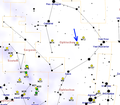M10 (球狀星團)
| Messier 10 | |
|---|---|
 蛇夫座中的球狀星團M10 | |
| 觀測數據(J2000 曆元) | |
| 分類 | VII[1] |
| 星座 | 蛇夫座 |
| 赤經 | 16h 57m 8.92s[2] |
| 赤緯 | -04° 05′ 58.07″[2] |
| 距離 | 14.3 kly(4.4 kpc)[3] |
| 視星等 (V) | 6.6[4] |
| 視直徑(V) | 20′.0 |
| 物理性質 | |
| Mass | 2.25 × 105[5] M☉ |
| 半徑 | 41.6 ly[6] |
| 金屬量 | –1.25[7] dex |
| 估計年齡 | 11.39 Gyr[7] |
| 其它名稱 | GCl-49、NGC 6254[8] |
梅西耶或M10(也稱為NGC 6254)是在赤道星座蛇夫座中的一個球狀星團。這個天體是法國天文學家查爾斯·梅西耶於1764年5月29日發現的,他將其編目為他的目錄中的第10號,並將其描述為「沒有恆星的星雲」。1774年,德國天文學家約翰·波德同樣描述其為「非常蒼白;沒有恆星的星雲斑塊」。德國出生的天文學家威廉·赫雪爾使用更大的望遠鏡,能夠將星團中的恆星解析出單顆的成員。他將其描述為「由極度壓縮的恆星組成的美麗星團」。羅斯伯爵認為他能分辨出穿過部分星團的黑暗小巷。第一個估計到星團距離的是哈羅·沙普利,然而他推導得出的33,000光年比現代值要遠得多[9]。
M10的潮汐半徑為19.3弧分,約為月球視直徑的三分之二。因為它明亮的核心只有35光年寬,通過中型望遠鏡觀察,它看起來大約是這個尺寸的一半(8-9弧分)。它的核心半徑為48弧秒,半質量半徑為147弧秒(2.5弧分)[2]。M10的空間直徑為83光年,估計距離地球14,300光年[3]。它位於蛇夫座的中心車肆增二(蛇夫座30)以西一度處[10]。
就氫和氦以外元素的豐度而言,天文學家稱之為金屬豐度,M10是「中等金屬貧乏」。鐵的豐度,量測為[Fe/H]等於-1.45±0.04dex,僅為太陽表面豐度的3.5%。這個星團顯示出被大質量恆星和II型超新星中的S-過程產生元素富集的證據。它幾乎沒有顯示出因Ia超新星富集的證據[11]
因為聯星的平均質量比正常恆星大,所以聯星往往會向星團中心遷移。聯星在核心區域的比例約為14%。這一比例隨著半徑的增加而下降,在星團的周邊區域約為1.5%[2]。相應地,核心區域包含了大量由恆星相互作用形成的藍離散星,其中大部分形成於20億至50億年前[12]。核心區域的恆星密度約為每立方秒差距3.8太陽質量[2]。在這個星團中已經發現了四顆變星。
這個星團現時位於銀河中心的5千秒差距(16千光年)附近[11]。它大約每1.4億年繞銀河系一周,在此期間,它每5,300萬年穿過銀河系盤面。其玫瑰花結軌道的離心率為0.21[5]。
圖集
[編輯]-
哈伯太空望遠鏡拍攝的梅西耶10號核心區域
-
顯示M10位置的星圖
相關條目
[編輯]參考資料
[編輯]- ^ Shapley, Harlow; Sawyer, Helen B., A Classification of Globular Clusters, Harvard College Observatory Bulletin, August 1927, 849 (849): 11–14, Bibcode:1927BHarO.849...11S.
- ^ 2.0 2.1 2.2 2.3 2.4 Dalessandro, E.; et al, The Binary Fraction in the Globular Cluster M10 (NGC 6254): Comparing Core and Outer Regions, The Astrophysical Journal, December 2011, 743 (1): 11, Bibcode:2011ApJ...743...11D, S2CID 119193839, arXiv:1108.5675
 , doi:10.1088/0004-637X/743/1/11.
, doi:10.1088/0004-637X/743/1/11.
- ^ 3.0 3.1 Bica, E.; et al, Globular cluster system and Milky Way properties revisited, Astronomy and Astrophysics, April 2006, 450 (1): 105–115, Bibcode:2006A&A...450..105B, S2CID 1559058, arXiv:astro-ph/0511788
 , doi:10.1051/0004-6361:20054351.
, doi:10.1051/0004-6361:20054351.
- ^ Messier 10. SEDS Messier Catalog. [27 April 2022]. (原始內容存檔於2023-06-26).
- ^ 5.0 5.1 Gnedin, Oleg Y.; Lee, Hyung Mok; Ostriker, Jeremiah P., Effects of Tidal Shocks on the Evolution of Globular Clusters, Astrophysical Journal, 1999, 522 (2): 935–949, Bibcode:1999ApJ...522..935G, S2CID 11143134, arXiv:astro-ph/9806245
 , doi:10.1086/307659.
, doi:10.1086/307659.
- ^ distance × sin( diameter_angle / 2 ) = 41.6 ly. radius
- ^ 7.0 7.1 Forbes, Duncan A.; Bridges, Terry, Accreted versus in situ Milky Way globular clusters, Monthly Notices of the Royal Astronomical Society, May 2010, 404 (3): 1203–1214, Bibcode:2010MNRAS.404.1203F, S2CID 51825384, arXiv:1001.4289
 , doi:10.1111/j.1365-2966.2010.16373.x.
, doi:10.1111/j.1365-2966.2010.16373.x.
- ^ M 10. SIMBAD. 斯特拉斯堡天文資料中心.
- ^ Burnham, Robert, Burnham's celestial handbook: an observer's guide to the universe beyond the Solar System, Dover Books on Astronomy 2 2nd, Courier Dover Publications: 1261, 1978, ISBN 978-0486235684.
- ^ O'Meara, Stephen James. Deep-Sky Companions: The Messier Objects. Cambridge University Press. 1998: 63. ISBN 9780521553322.
- ^ 11.0 11.1 Haynes, Sharina; Burks, Geoffrey; Johnson, Christian I.; Pilachowski, Catherine A., Chemical Analysis of Five Red Giants in the Globular Cluster M10 (NGC 6254), The Publications of the Astronomical Society of the Pacific, October 2008, 120 (872): 1097–1102, Bibcode:2008PASP..120.1097H, S2CID 119203399, arXiv:0808.2480
 , doi:10.1086/592717.
, doi:10.1086/592717.
- ^ Ferraro, Francesco R.; et al, Blue Straggler Stars: A Direct Comparison of Star Counts and Population Ratios in Six Galactic Globular Clusters, The Astrophysical Journal, May 2003, 588 (1): 464–477, Bibcode:2003ApJ...588..464F, S2CID 16109989, arXiv:astro-ph/0301261
 , doi:10.1086/374042.
, doi:10.1086/374042.
外部連結
[編輯]- Messier 10, SEDS Messier pages (頁面存檔備份,存於網際網路檔案館)
- Messier 10, Galactic Globular Clusters Database page (頁面存檔備份,存於網際網路檔案館)
- WikiSky上關於M10 (球狀星團)的內容:DSS2, SDSS, GALEX, IRAS, 氫α, X射線, 天文照片, 天圖, 文章和圖片


